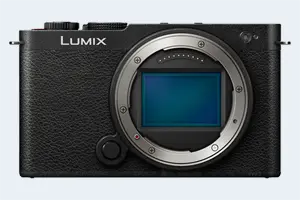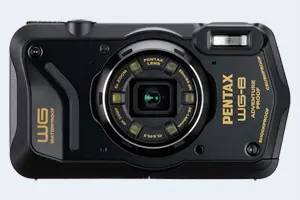Panasonic S9 vs Pentax WG-8
The Panasonic Lumix DC-S9 and the Pentax WG-8 are two digital cameras that were announced, respectively, in May 2024 and June 2024. The S9 is a mirrorless interchangeable lens camera, while the WG-8 is a fixed lens compact. The cameras are based on a full frame (S9) and a 1/2.3-inch (WG-8) sensor. The Panasonic has a resolution of 24 megapixels, whereas the Pentax provides 20.2 MP.
Below is an overview of the main specs of the two cameras as a starting point for the comparison.

Check S9 price at
amazon.com

Check WG-8 price at
amazon.com
Going beyond this snapshot of core features and characteristics, what are the differences between the Panasonic Lumix DC-S9 and the Pentax WG-8? Which one should you buy? Read on to find out how these two cameras compare with respect to their body size, their imaging sensors, their shooting features, their input-output connections, and their reception by expert reviewers.
Body comparison
The side-by-side display below illustrates the physical size and weight of the Panasonic S9 and the Pentax WG-8. The two cameras are presented according to their relative size. Three consecutive perspectives from the front, the top, and the back are available. All width, height and depth dimensions are rounded to the nearest millimeter.
The S9 can be obtained in four different colors (black, blue, red, green), while the WG-8 is available in two color-versions (black, green).
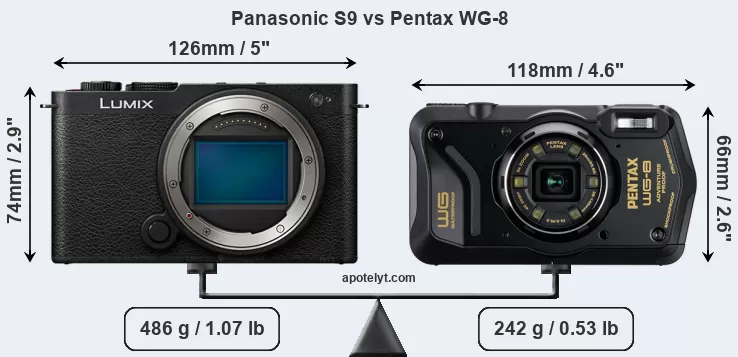

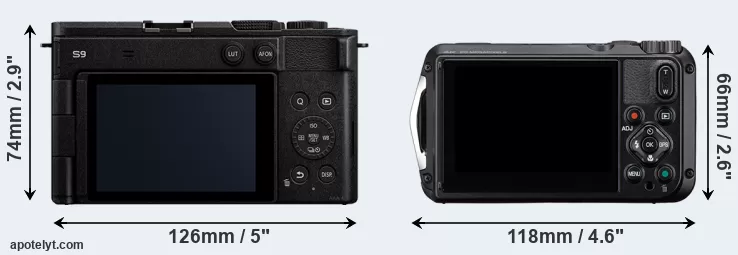
If the front view area (width x height) of the cameras is taken as an aggregate measure of their size, the Pentax WG-8 is notably smaller (16 percent) than the Panasonic S9. It is noteworthy in this context that the WG-8 is splash and dust-proof, while the S9 does not feature any corresponding weather-sealing. More than that, the WG-8 is water-proof up to 20m and can, thus, be used for underwater photography.
The above size and weight comparisons are to some extent incomplete and possibly misleading, as the WG-8 has a lens built in, whereas the S9 is an interchangeable lens camera that requires a separate lens. Attaching the latter will add extra weight and bulk to the setup.
Concerning battery life, the S9 gets 470 shots out of its Panasonic DMW-BLK22 battery, while the WG-8 can take 340 images on a single charge of its Ricoh DB-110 power pack. The power pack in the S9 can be charged via the USB port, so that it is not always necessary to take the battery charger along when travelling.
The following table provides a synthesis of the main physical specifications of the two cameras and other similar ones. In case you want to display and compare another camera duo, you can use the CAM-parator app to select your camera combination among a large number of options.

| Camera Model |
Camera Width |
Camera Height |
Camera Depth |
Camera Weight |
Battery Life |
Weather Sealing |
Camera Launch |
Launch Price |
Street Price |
||
|---|---|---|---|---|---|---|---|---|---|---|---|
| 1. | Panasonic S9 | 126 mm | 74 mm | 47 mm | 486 g | 470 | n | May 2024 | US$ 1 499 | amazon.com | |
| 2. | Pentax WG-8 | 118 mm | 66 mm | 33 mm | 242 g | 340 | Y | Jun 2024 | US$ 399 | amazon.com | |
| 3. | Canon R8 | 133 mm | 86 mm | 70 mm | 461 g | 220 | n | Feb 2023 | US$ 1 499 | amazon.com | |
| 4. | Fujifilm X-S10 | 126 mm | 85 mm | 65 mm | 465 g | 325 | n | Oct 2020 | US$ 999 | amazon.com | |
| 5. | Fujifilm X-S20 | 128 mm | 85 mm | 65 mm | 491 g | 750 | n | May 2023 | US$ 1 299 | amazon.com | |
| 6. | Fujifilm X100VI | 128 mm | 75 mm | 55 mm | 521 g | 450 | Y | Feb 2024 | US$ 1 599 | amazon.com | |
| 7. | Nikon W300 | 112 mm | 66 mm | 29 mm | 231 g | 280 | Y | May 2017 | US$ 389 | ebay.com | |
| 8. | Panasonic FT7 | 117 mm | 76 mm | 37 mm | 319 g | 300 | Y | May 2018 | US$ 449 | ebay.com | |
| 9. | Panasonic G9 II | 134 mm | 102 mm | 90 mm | 658 g | 390 | Y | Sep 2023 | US$ 1 899 | amazon.com | |
| 10. | Panasonic GH5 II | 139 mm | 98 mm | 87 mm | 727 g | 400 | Y | May 2021 | US$ 1 699 | amazon.com | |
| 11. | Panasonic GX9 | 124 mm | 72 mm | 47 mm | 407 g | 260 | n | Feb 2018 | US$ 849 | ebay.com | |
| 12. | Panasonic S5 II | 134 mm | 102 mm | 90 mm | 740 g | 370 | Y | Jan 2023 | US$ 1 999 | amazon.com | |
| 13. | Pentax WG-1000 | 116 mm | 69 mm | 51 mm | 220 g | 300 | Y | Jun 2024 | US$ 229 | amazon.com | |
| 14. | Ricoh WG-6 | 118 mm | 66 mm | 33 mm | 246 g | 340 | Y | Feb 2019 | US$ 399 | amazon.com | |
| 15. | Sony A7C | 124 mm | 71 mm | 60 mm | 509 g | 740 | Y | Sep 2020 | US$ 1 799 | amazon.com | |
| 16. | Sony A6700 | 122 mm | 69 mm | 64 mm | 493 g | 570 | Y | Jul 2023 | US$ 1 399 | amazon.com | |
| 17. | Sony HX99 | 102 mm | 58 mm | 36 mm | 242 g | 370 | n | Aug 2018 | US$ 449 | ebay.com | |
| Note: Measurements and pricing do not include easily detachable parts, such as add-on or interchangeable lenses or optional viewfinders. | |||||||||||
Any camera decision will naturally be influenced heavily by the price. The listed launch prices provide an indication of the market segment that the manufacturer of the cameras have been targeting. The WG-8 was launched at a lower price than the S9, despite having a lens built in. Usually, retail prices stay at first close to the launch price, but after several months, discounts become available. Later in the product cycle and, in particular, when the replacement model is about to appear, further discounting and stock clearance sales often push the camera price considerably down. Then, after the new model is out, very good deals can frequently be found on the pre-owned market.
Sensor comparison
The size of the sensor inside a digital camera is one of the key determinants of image quality. All other things equal, a large sensor will have larger individual pixel-units that offer better low-light sensitivity, wider dynamic range, and richer color-depth than smaller pixels in a sensor of the same technological generation. Further, a large sensor camera will give the photographer additional creative options when using shallow depth-of-field to isolate a subject from its background. On the downside, larger sensors tend to be associated with larger, more expensive camera bodies and lenses.
Of the two cameras under consideration, the Panasonic S9 features a full frame sensor and the Pentax WG-8 a 1/2.3-inch sensor. The sensor area in the WG-8 is 97 percent smaller. As a result of these sensor size differences, the cameras have a format factor of, respectively, 1.0 and 5.6. The sensor in the S9 has a native 3:2 aspect ratio, while the one in the WG-8 offers a 4:3 aspect.
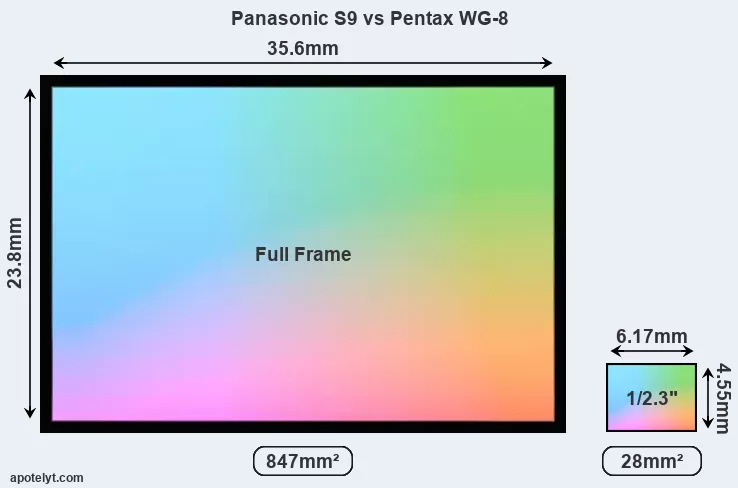
With 24MP, the S9 offers a higher resolution than the WG-8 (20.2MP), but the S9 nevertheless has larger individual pixels (pixel pitch of 5.94μm versus 1.18μm for the WG-8) due to its larger sensor. It is noteworthy in this context that the two cameras were released in close succession, so that their sensors are from the same technological generation. Coming back to sensor resolution, it should be mentioned that neither of the two cameras has an anti-alias filter installed, so they are able to capture all the detail the sensor resolves.
The resolution advantage of the Panasonic S9 implies greater flexibility for cropping images or the possibility to print larger pictures. The maximum print size of the S9 for good quality output (200 dots per inch) amounts to 30 x 20 inches or 76.2 x 50.8 cm, for very good quality (250 dpi) 24 x 16 inches or 61 x 40.6 cm, and for excellent quality (300 dpi) 20 x 13.3 inches or 50.8 x 33.9 cm. The corresponding values for the Pentax WG-8 are 25.9 x 19.4 inches or 65.8 x 49.4 cm for good quality, 20.7 x 15.6 inches or 52.7 x 39.5 cm for very good quality, and 17.3 x 13 inches or 43.9 x 32.9 cm for excellent quality prints.
The S9 has on-sensor phase detect pixels, which results in fast and reliable autofocus acquisition even during live view operation.
The Panasonic Lumix DC-S9 has a native sensitivity range from ISO 100 to ISO 51200, which can be extended to ISO 50-204800. The corresponding ISO settings for the Pentax WG-8 are ISO 125 to ISO 6400 (no boost).
In terms of underlying technology, the S9 is build around a BSI-CMOS sensor, while the WG-8 uses a CMOS imager. Both cameras use a Bayer filter for capturing RGB colors on a square grid of photosensors. This arrangement is found in most digital cameras.
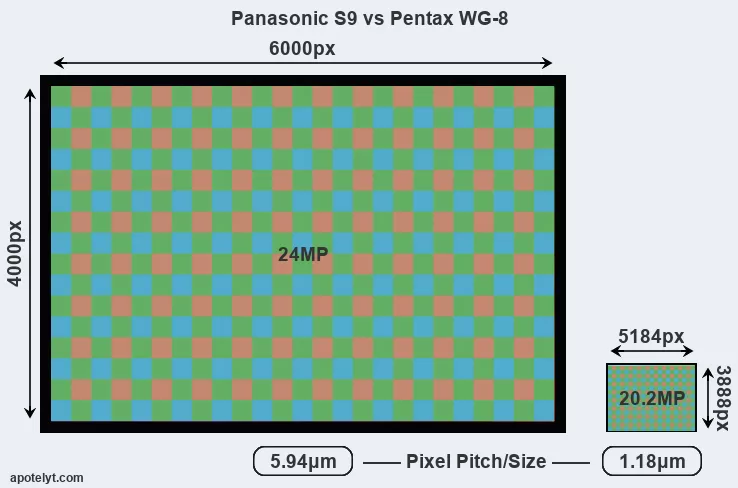
Since 2007, DXO Mark has published sensor performance measurements that have been derived using a consistent methodology. This service is based on lab testing and assigns an overall score to each camera sensor, as well as ratings for dynamic range ("DXO Landscape"), color depth ("DXO Portrait"), and low-light sensitivity ("DXO Sports"). The adjacent table reports on the physical sensor characteristics and the outcomes of the DXO sensor quality tests for a sample of comparator-cameras.

| Camera Model |
Sensor Class |
Resolution (MP) |
Horiz. Pixels |
Vert. Pixels |
Video Format |
DXO Portrait |
DXO Landscape |
DXO Sports |
DXO Overall |
||
|---|---|---|---|---|---|---|---|---|---|---|---|
| 1. | Panasonic S9 | Full Frame | 24.0 | 6000 | 4000 | 6K/30p | 25.4 | 14.8 | 3297 | 96 | |
| 2. | Pentax WG-8 | 1/2.3 | 20.2 | 5184 | 3888 | 4K/30p | 20.9 | 12.8 | 1626 | 54 | |
| 3. | Canon R8 | Full Frame | 24.0 | 6000 | 4000 | 4k/60p | 24.5 | 14.7 | 3295 | 93 | |
| 4. | Fujifilm X-S10 | APS-C | 26.0 | 6240 | 4160 | 4K/30p | 24.2 | 13.7 | 2057 | 85 | |
| 5. | Fujifilm X-S20 | APS-C | 26.0 | 6240 | 4160 | 4K/60p | 24.3 | 14.0 | 2315 | 86 | |
| 6. | Fujifilm X100VI | APS-C | 39.8 | 7728 | 5152 | 6.2K/30p | 24.3 | 14.1 | 2397 | 86 | |
| 7. | Nikon W300 | 1/2.3 | 15.9 | 4608 | 3456 | 4K/30p | 20.5 | 12.0 | 938 | 50 | |
| 8. | Panasonic FT7 | 1/2.3 | 20.2 | 5184 | 3888 | 4K/30p | 20.6 | 12.1 | 1028 | 51 | |
| 9. | Panasonic G9 II | Four Thirds | 25.0 | 5776 | 4336 | 5.7K/60p | 23.4 | 13.5 | 1710 | 78 | |
| 10. | Panasonic GH5 II | Four Thirds | 20.2 | 5184 | 3888 | 4K/60p | 23.7 | 13.1 | 1136 | 79 | |
| 11. | Panasonic GX9 | Four Thirds | 20.2 | 5184 | 3888 | 4K/30p | 23.1 | 12.8 | 1163 | 74 | |
| 12. | Panasonic S5 II | Full Frame | 24.0 | 6000 | 4000 | 6K/30p | 25.4 | 14.6 | 3158 | 96 | |
| 13. | Pentax WG-1000 | 1/2.3 | 15.9 | 4608 | 3456 | 1080/30p | 20.9 | 12.8 | 1626 | 54 | |
| 14. | Ricoh WG-6 | 1/2.3 | 20.2 | 5184 | 3888 | 4K/30p | 20.7 | 12.2 | 1104 | 52 | |
| 15. | Sony A7C | Full Frame | 24.0 | 6000 | 4000 | 4K/30p | 25.0 | 14.7 | 3407 | 95 | |
| 16. | Sony A6700 | APS-C | 25.6 | 6192 | 4128 | 4K/120p | 24.3 | 14.0 | 2329 | 86 | |
| 17. | Sony HX99 | 1/2.3 | 18.0 | 4896 | 3672 | 4K/30p | 20.6 | 12.1 | 1058 | 51 | |
| Note: DXO values in italics represent estimates based on sensor size and age. | |||||||||||
Many modern cameras are not only capable of taking still images, but also of capturing video footage. Both cameras under consideration have a sensor with sufficiently fast read-out times for moving pictures, but the S9 provides a higher video resolution than the WG-8. It can shoot video footage at 6K/30p, while the Pentax is limited to 4K/30p.
Feature comparison
Apart from body and sensor, cameras can and do differ across a variety of features. The S9 and the WG-8 are similar in the sense that neither of the two has a viewfinder. The images are, thus, framed using live view on the rear LCD. The adjacent table lists some of the other core features of the Panasonic S9 and Pentax WG-8 along with similar information for a selection of comparators.

| Camera Model |
Viewfinder (Type or 000 dots) |
Control Panel (yes/no) |
LCD Specifications (inch/000 dots) |
LCD Attach- ment |
Touch Screen (yes/no) |
Max Shutter Speed * |
Max Shutter Flaps * |
Built-in Flash (yes/no) |
Built-in Image Stab |
||
|---|---|---|---|---|---|---|---|---|---|---|---|
| 1. | Panasonic S9 | none | n | 3.0 / 1840 | swivel | Y | 1/8000s | 30.0/s | n | Y | |
| 2. | Pentax WG-8 | none | n | 3.0 / 1040 | fixed | n | 1/4000s | 8.0/s | Y | n | |
| 3. | Canon R8 | 2360 | n | 3.0 / 1620 | swivel | Y | 1/4000s | 6.0/s | n | n | |
| 4. | Fujifilm X-S10 | 2360 | n | 3.0 / 1040 | swivel | Y | 1/4000s | 8.0/s | Y | Y | |
| 5. | Fujifilm X-S20 | 2360 | n | 3.0 / 1840 | swivel | Y | 1/4000s | 8.0/s | Y | Y | |
| 6. | Fujifilm X100VI | 3690 | n | 3.0 / 1620 | tilting | Y | 1/4000s | 11.0/s | n | Y | |
| 7. | Nikon W300 | none | n | 3.0 / 921 | fixed | n | 1/4000s | 7.0/s | Y | Y | |
| 8. | Panasonic FT7 | 1170 | n | 3.0 / 1040 | fixed | n | 1/1300s | 10.0/s | Y | Y | |
| 9. | Panasonic G9 II | 3680 | n | 3.0 / 1840 | swivel | Y | 1/8000s | 10.0/s | n | Y | |
| 10. | Panasonic GH5 II | 3680 | n | 3.0 / 1840 | swivel | Y | 1/8000s | 12.0/s | n | Y | |
| 11. | Panasonic GX9 | 2760 | n | 3.0 / 1240 | tilting | Y | 1/4000s | 9.0/s | Y | Y | |
| 12. | Panasonic S5 II | 3680 | n | 3.0 / 1840 | swivel | Y | 1/8000s | 9.0/s | n | Y | |
| 13. | Pentax WG-1000 | none | n | 2.7 / 230 | fixed | n | 1/2000s | 8.0/s | Y | n | |
| 14. | Ricoh WG-6 | none | n | 3.0 / 1040 | fixed | n | 1/4000s | 1.0/s | Y | n | |
| 15. | Sony A7C | 2360 | n | 3.0 / 922 | swivel | Y | 1/4000s | 10.0/s | n | Y | |
| 16. | Sony A6700 | 2360 | n | 3.0 / 1037 | swivel | Y | 1/4000s | 11.0/s | n | Y | |
| 17. | Sony HX99 | 638 | n | 3.0 / 922 | tilting | Y | 1/2000s | 10.0/s | Y | Y | |
| Note: *) Information refers to the mechanical shutter, unless the camera only has an electronic one. | |||||||||||
One differentiating feature between the two cameras concerns the touch sensitivity of the rear screen. The S9 has a touchscreen, while the WG-8 has a conventional panel. Touch control can be particularly helpful, for example, for setting the focus point.
The S9 has an articulated LCD that can be turned to be front-facing. This characteristic will be appreciated by vloggers and photographers who are interested in snapping selfies. In contrast, the WG-8 does not have a selfie-screen.The reported shutter speed information refers to the use of the mechanical shutter. Yet, some cameras only have an electronic shutter, while others have an electronic shutter in addition to a mechanical one. In fact, both cameras under consideration feature an electronic shutter, which makes completely silent shooting possible. However, this mode is less suitable for photographing moving objects (risk of rolling shutter) or shooting under artificial light sources (risk of flickering).
The Panasonic S9 and the Pentax WG-8 both have an intervalometer built-in. This enables the photographer to capture time lapse sequences, such as flower blooming, a sunset or moon rise, without purchasing an external camera trigger and related software.
Concerning the storage of imaging data, both the S9 and the WG-8 write their files to SDXC cards. The S9 supports UHS-II cards (Ultra High Speed data transfer of up to 312 MB/s), while the WG-8 cannot take advantage of Ultra High Speed SD cards.
Connectivity comparison
For some imaging applications, the extent to which a camera can communicate with its environment can be an important aspect in the camera decision process. The table below provides an overview of the connectivity of the Panasonic Lumix DC-S9 and Pentax WG-8 and, in particular, the interfaces the cameras (and selected comparators) provide for accessory control and data transfer.

| Camera Model |
Hotshoe Port |
Internal Mic / Speaker |
Microphone Port |
Headphone Port |
HDMI Port |
USB Port |
WiFi Support |
NFC Support |
Bluetooth Support |
||
|---|---|---|---|---|---|---|---|---|---|---|---|
| 1. | Panasonic S9 | Y | stereo / mono | Y | - | micro | 3.2 | Y | - | Y | |
| 2. | Pentax WG-8 | - | mono / mono | - | - | - | 3.0 | - | - | - | |
| 3. | Canon R8 | Y | stereo / mono | Y | Y | micro | 3.2 | Y | - | Y | |
| 4. | Fujifilm X-S10 | Y | stereo / mono | Y | - | micro | 3.2 | Y | - | Y | |
| 5. | Fujifilm X-S20 | Y | stereo / mono | Y | Y | micro | 3.2 | Y | - | Y | |
| 6. | Fujifilm X100VI | Y | stereo / mono | Y | - | micro | 3.2 | Y | - | Y | |
| 7. | Nikon W300 | - | stereo / mono | - | - | micro | 2.0 | Y | - | Y | |
| 8. | Panasonic FT7 | - | stereo / mono | - | - | micro | 2.0 | Y | - | - | |
| 9. | Panasonic G9 II | Y | stereo / mono | Y | Y | full | 3.2 | Y | - | Y | |
| 10. | Panasonic GH5 II | Y | stereo / mono | Y | Y | full | 3.2 | Y | - | Y | |
| 11. | Panasonic GX9 | Y | stereo / mono | - | - | micro | 2.0 | Y | - | Y | |
| 12. | Panasonic S5 II | Y | stereo / mono | Y | Y | full | 3.2 | Y | - | Y | |
| 13. | Pentax WG-1000 | - | mono / mono | - | - | - | 2.0 | - | - | - | |
| 14. | Ricoh WG-6 | - | mono / mono | - | - | micro | 3.0 | - | - | - | |
| 15. | Sony A7C | Y | stereo / mono | Y | Y | micro | 3.2 | Y | Y | Y | |
| 16. | Sony A6700 | Y | stereo / mono | Y | Y | YES | 3.2 | Y | Y | Y | |
| 17. | Sony HX99 | - | stereo / mono | - | - | micro | 2.0 | Y | Y | Y |
It is notable that the S9 has a hotshoe, while the WG-8 does not. This socket makes it possible to easily attach optional accessories, such as an external flash gun.
Both the S9 and the WG-8 are recent models that are part of the current product line-up. Neither of the two has a direct predecessor, so perhaps they will constitute the origins of new camera lines for Panasonic and Pentax. Further information on the two cameras (e.g. user guides, manuals), as well as related accessories, can be found on the official Panasonic and Pentax websites.
Review summary
So how do things add up? Is there a clear favorite between the Panasonic S9 and the Pentax WG-8? Which camera is better? Below is a summary of the relative strengths of each of the two contestants.

Advantages of the Panasonic Lumix DC-S9:
- More detail: Offers more megapixels (24 vs 20.2MP) with a 11% higher linear resolution.
- Better image quality: Features bigger pixels on a larger sensor for higher quality imaging.
- Richer colors: The pixel size advantage translates into images with better, more accurate colors.
- More dynamic range: Larger pixels capture a wider spectrum of light and dark details.
- Better low-light sensitivity: Larger pixels means good image quality even under poor lighting.
- Better video: Provides higher definition movie capture (6K/30p vs 4K/30p).
- Better live-view autofocus: Features on-sensor phase-detection for more confident autofocus.
- Better sound: Can connect to an external microphone for higher quality sound recording.
- More detailed LCD: Has a higher resolution rear screen (1840k vs 1040k dots).
- More flexible LCD: Has a swivel screen for odd-angle shots in portrait or landscape orientation.
- Fewer buttons to press: Is equipped with a touch-sensitive rear screen to facilitate handling.
- More selfie-friendly: Has an articulated screen that can be turned to be front-facing.
- Faster shutter: Has higher mechanical shutter speed (1/8000s vs 1/4000s) to freeze action.
- Faster burst: Shoots at higher frequency (30 vs 8 flaps/sec) to capture the decisive moment.
- More flexible: Accepts interchangeable lenses, so that lens characteristics can be altered.
- Longer lasting: Can take more shots (470 versus 340) on a single battery charge.
- Easier travel charging: Can be conveniently charged via its USB port.
- Sharper images: Has hand-shake reducing image stabilization built-in.
- Better lighting: Features a hotshoe and can thus hold and trigger an external flash gun.
- Easier file upload: Has wifi built in for automatic backup or image transfer to the web.
- Easier wireless transfer: Supports Bluetooth for image sharing without cables.
- Faster buffer clearing: Supports Ultra High Speed (UHS-II) SDXC cards.

Arguments in favor of the Pentax WG-8:
- Ready to shoot: Has an integrated lens, whereas the S9 necessitates an extra lens.
- More compact: Is smaller (118x66mm vs 126x74mm) and will fit more readily into a bag.
- Less heavy: Has a lower weight even though it has a lens built in (unlike the S9).
- Better sealing: Is splash and dust sealed for shooting in inclement weather conditions.
- Water-proof: Is rugged and sealed and can thus be used for underwater photography (up to 20m).
- Easier fill-in: Has a small integrated flash to brighten shadows of backlit subjects.
- More affordable: Was introduced at a lower price, despite coming with a built-in lens.
If the count of individual advantages (bullet points above) is taken as a guide, the S9 is the clear winner of the match-up (22 : 7 points). However, the relative importance of the various individual camera aspects will vary according to personal preferences and needs, so that you might like to apply corresponding weights to the particular features before making a decision on a new camera. A professional wildlife photographer will view the differences between cameras in a way that diverges from the perspective of a family photog, and a person interested in architecture has distinct needs from a sports shooter. Hence, the decision which camera is best and worth buying is often a very personal one.
How about other alternatives? Do the specifications of the Panasonic S9 and the Pentax WG-8 place the cameras among the top in their class? Find out in the latest Best Mirrorless Interchangeable Lens Camera and Best Travel-Zoom Camera listings whether the two cameras rank among the cream of the crop.
In any case, while the comparison of the spec-sheets of cameras can offer a general idea of their imaging potential, it says little about, for example, the shooting experience and imaging performance of the S9 and the WG-8 in practical situations. At times, user reviews, such as those published at amazon, address these issues in a useful manner, but such feedback is on many occasions incomplete, inconsistent, and unreliable.
Expert reviews
This is why hands-on reviews by experts are important. The adjacent summary-table relays the overall verdicts of several of the most popular camera review sites (amateurphotographer [AP], cameralabs [CL], digitalcameraworld [DCW], dpreview [DPR], ephotozine [EPZ], photographyblog [PB]). As can be seen, the professional reviewers agree in many cases on the quality of different cameras, but sometimes their assessments diverge, reinforcing the earlier point that a camera decision is often a very personal choice.

| Camera Model |
AP score |
CL score |
DCW score |
DPR score |
EPZ score |
PB score |
Camera Launch |
Launch Price |
Street Price |
||
|---|---|---|---|---|---|---|---|---|---|---|---|
| 1. | Panasonic S9 | .. | .. | .. | .. | .. | .. | May 2024 | US$ 1 499 | amazon.com | |
| 2. | Pentax WG-8 | .. | .. | .. | .. | .. | .. | Jun 2024 | US$ 399 | amazon.com | |
| 3. | Canon R8 | 4.5/5 | + + | 4.5/5 | 87/100 | 4/5 | 4.5/5 | Feb 2023 | US$ 1 499 | amazon.com | |
| 4. | Fujifilm X-S10 | 5/5 | .. | 4.5/5 | 86/100 | 4.5/5 | 4.5/5 | Oct 2020 | US$ 999 | amazon.com | |
| 5. | Fujifilm X-S20 | 5/5 | + + | 5/5 | 86/100 | .. | 4.5/5 | May 2023 | US$ 1 299 | amazon.com | |
| 6. | Fujifilm X100VI | 5/5 | + + | 4.5/5 | 87/100 | .. | 4.5/5 | Feb 2024 | US$ 1 599 | amazon.com | |
| 7. | Nikon W300 | .. | + | .. | .. | 4/5 | 4/5 | May 2017 | US$ 389 | ebay.com | |
| 8. | Panasonic FT7 | .. | + | .. | .. | 3.5/5 | 3.5/5 | May 2018 | US$ 449 | ebay.com | |
| 9. | Panasonic G9 II | 5/5 | .. | 4.5/5 | 87/100 | .. | 4.5/5 | Sep 2023 | US$ 1 899 | amazon.com | |
| 10. | Panasonic GH5 II | 4.5/5 | .. | 4.5/5 | 85/100 | 4.5/5 | 5/5 | May 2021 | US$ 1 699 | amazon.com | |
| 11. | Panasonic GX9 | 4/5 | + | 4/5 | 84/100 | 4.5/5 | 4.5/5 | Feb 2018 | US$ 849 | ebay.com | |
| 12. | Panasonic S5 II | 4.5/5 | + + | 5/5 | 90/100 | 4.5/5 | 5/5 | Jan 2023 | US$ 1 999 | amazon.com | |
| 13. | Pentax WG-1000 | .. | .. | .. | .. | .. | .. | Jun 2024 | US$ 229 | amazon.com | |
| 14. | Ricoh WG-6 | .. | .. | .. | .. | 3.5/5 | 3.5/5 | Feb 2019 | US$ 399 | amazon.com | |
| 15. | Sony A7C | 3.5/5 | .. | 3.5/5 | 86/100 | 4/5 | 4/5 | Sep 2020 | US$ 1 799 | amazon.com | |
| 16. | Sony A6700 | 4.5/5 | + | 4.5/5 | 88/100 | 4.5/5 | 4.5/5 | Jul 2023 | US$ 1 399 | amazon.com | |
| 17. | Sony HX99 | .. | .. | .. | .. | 4/5 | 4.5/5 | Aug 2018 | US$ 449 | ebay.com | |
| Note: (+ +) highly recommended; (+) recommended; (o) reviewed; (..) not available. | |||||||||||
The above review scores should be interpreted with care, though. The ratings were established in reference to similarly priced cameras that were available in the market at the time of the review. Thus, a score needs to be put into the context of the launch date and the launch price of the camera, and comparing ratings of very distinct cameras or ones that are far apart in terms of their release date have little meaning. It should also be noted that some of the review sites have over time altered the way they render their verdicts.

Check S9 price at
amazon.com

Check WG-8 price at
amazon.com
Other camera comparisons
Did this review help to inform your camera decision process? In case you are interested in seeing how other cameras pair up, just make a corresponding selection in the search boxes below. Alternatively, you can follow any of the listed hyperlinks for comparisons that others found interesting.
- Canon 850D vs Pentax WG-8
- Canon R7 vs Panasonic S9
- Canon T8i vs Panasonic S9
- Fujifilm GFX 100 II vs Panasonic S9
- Fujifilm X-Pro3 vs Panasonic S9
- Leica SL3 vs Pentax WG-8
- Panasonic G9 II vs Pentax WG-8
- Panasonic S9 vs Sigma fp L
- Panasonic S9 vs Sony A7R V
- Pentax WG-8 vs Ricoh GR IIIx
- Pentax WG-8 vs Sony A1
- Pentax WG-8 vs Sony A7C II
Specifications: Panasonic S9 vs Pentax WG-8
Below is a side-by-side comparison of the specs of the two cameras to facilitate a quick review of their differences and common features.
| Camera Model | Panasonic S9 | Pentax WG-8 |
|---|---|---|
| Camera Type | Mirrorless system camera | Fixed lens compact camera |
| Camera Lens | Leica L mount lenses | 28-140mm f/3.5-5.5 |
| Launch Date | May 2024 | June 2024 |
| Launch Price | USD 1,499 | USD 399 |
| Sensor Specs | Panasonic S9 | Pentax WG-8 |
| Sensor Technology | BSI-CMOS | CMOS |
| Sensor Format | Full Frame Sensor | 1/2.3" Sensor |
| Sensor Size | 35.6 x 23.8 mm | 6.17 x 4.55 mm |
| Sensor Area | 847.28 mm2 | 28.0735 mm2 |
| Sensor Diagonal | 42.8 mm | 7.7 mm |
| Crop Factor | 1.0x | 5.6x |
| Sensor Resolution | 24 Megapixels | 20.2 Megapixels |
| Image Resolution | 6000 x 4000 pixels | 5184 x 3888 pixels |
| Pixel Pitch | 5.94 μm | 1.18 μm |
| Pixel Density | 2.83 MP/cm2 | 71.80 MP/cm2 |
| Moiré control | no AA filter | no AA filter |
| Movie Capability | 6K/30p Video | 4K/30p Video |
| ISO Setting | 100 - 51,200 ISO | 125 - 6,400 ISO |
| ISO Boost | 50 - 204,800 ISO | no Enhancement |
| Screen Specs | Panasonic S9 | Pentax WG-8 |
| Viewfinder Type | no viewfinder | no viewfinder |
| LCD Framing | Live View | Live View |
| Rear LCD Size | 3.0inch | 3.0inch |
| LCD Resolution | 1840k dots | 1040k dots |
| LCD Attachment | Swivel screen | Fixed screen |
| Touch Input | Touchscreen | no Touchscreen |
| Shooting Specs | Panasonic S9 | Pentax WG-8 |
| Focus System | On-Sensor Phase-detect | Contrast-detect AF |
| Manual Focusing Aid | Focus Peaking | no Peaking Feature |
| Continuous Shooting | 30 shutter flaps/s | 8 shutter flaps/s |
| Electronic Shutter | up to 1/8000s | up to 1/4000s |
| Time-Lapse Photography | Intervalometer built-in | Intervalometer built-in |
| Image Stabilization | In-body stabilization | no handshake reduction |
| Fill Flash | no On-Board Flash | Built-in Flash |
| Storage Medium | SDXC cards | SDXC cards |
| Single or Dual Card Slots | Single card slot | Single card slot |
| UHS card support | UHS-II | no |
| Connectivity Specs | Panasonic S9 | Pentax WG-8 |
| External Flash | Hotshoe | no Hotshoe |
| USB Connector | USB 3.2 | USB 3.0 |
| HDMI Port | micro HDMI | no HDMI |
| Microphone Port | External MIC port | no MIC socket |
| Wifi Support | Wifi built-in | no Wifi |
| Bluetooth Support | Bluetooth built-in | no Bluetooth |
| Body Specs | Panasonic S9 | Pentax WG-8 |
| Environmental Sealing | not weather sealed | Waterproof body (20m) |
| Battery Type | Panasonic DMW-BLK22 | Ricoh DB-110 |
| Battery Life (CIPA) | 470 shots per charge | 340 shots per charge |
| In-Camera Charging | USB charging | no USB charging |
| Body Dimensions |
126 x 74 x 47 mm (5.0 x 2.9 x 1.9 in) |
118 x 66 x 33 mm (4.6 x 2.6 x 1.3 in) |
| Camera Weight | 486 g (17.1 oz) | 242 g (8.5 oz) |

Check S9 price at
amazon.com

Check WG-8 price at
amazon.com
Did you notice an error on this page? If so, please get in touch, so that we can correct the information.
